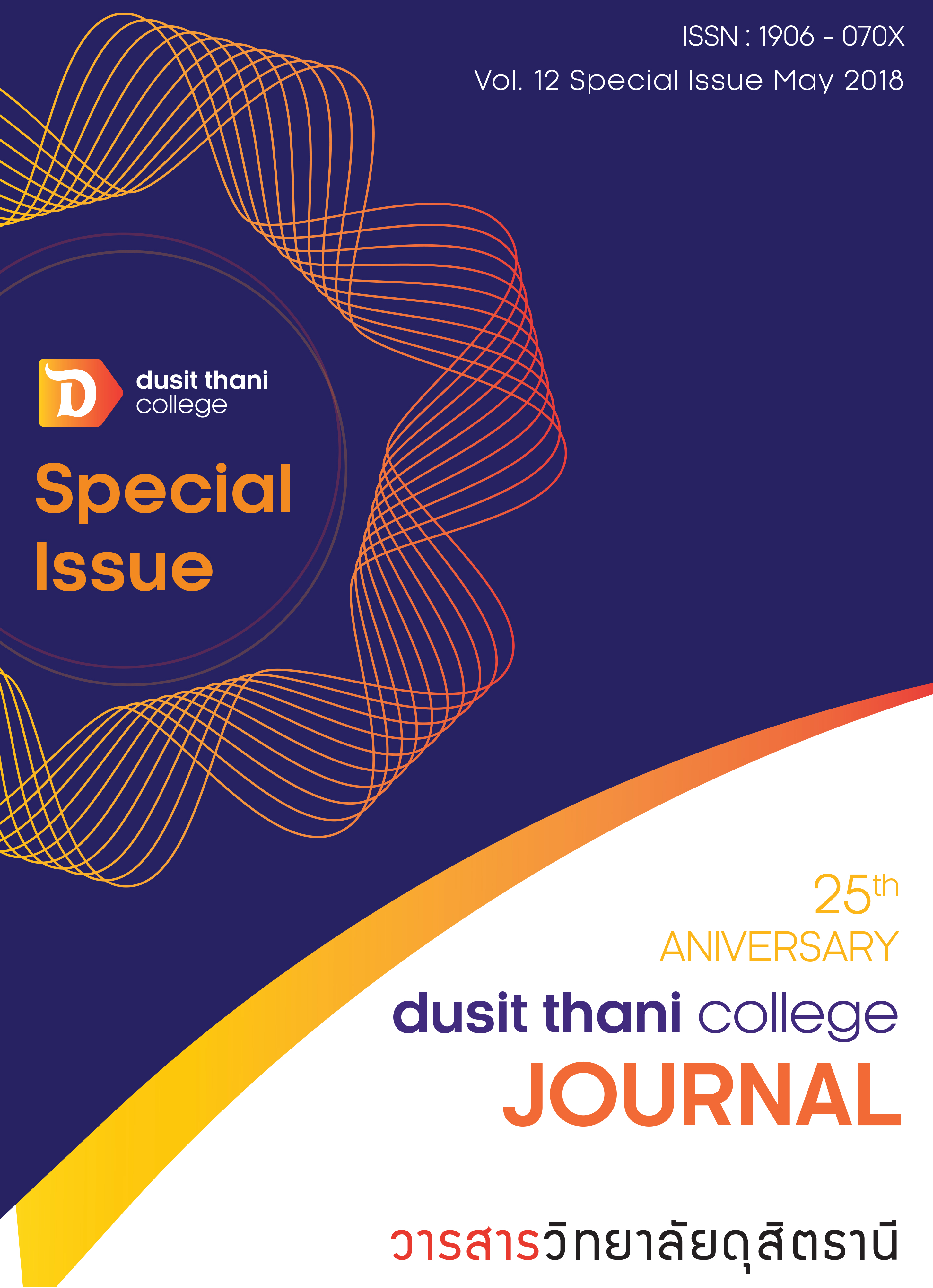Integrating of Menu Engineering and Electronic Word of Mouth Towards Restaurant Business
Main Article Content
Abstract
This article presents a change in consumer behaviors when social media has an impact in decision making. For this reason, restaurants have been affected in many different perspectives especially in term of Menu Engineering.
From the past, Menu engineering can be a useful tool as its provide strategies and tactics to increases in the profitability of restaurant menu. Restaurant industry has used menu engineering to analyse which dishes perform well, and to promote them. At the same time, they also use menu engineering to reduce food cost or remove dishes, which are not selling well or give low profit performance. Large food service operations such as hotels, use computer programmes to help analyse and establish menu prices.
Although this may be true that Electronic Word of Mouth (eWOM) has become one of the considerable factors in consumer behaviors change on these days. As a matter of fact, if restaurant could potentially combine the Menu Engineering concept along together with Electronic Word of Mouth (eWOM). This could present a more window of opportunity for businesses and understand in online consumer behavior change which can reach a multitude of customer at the same time.
Article Details
Article Screening Policy
- All research and academic articles to be published must be considered and screened by three peer reviews in the relevant field / article.
- All articles, texts, illustrations and tables published in the journal are the personal opinions of the authors. Editors don't always have to agree. And no responsibility whatsoever is the sole responsibility of the author.
- The articles to be published must never be published. Where did you first publish? And not in the consideration of other journals If the audit found that there has been a duplicate publication It is the sole responsibility of the author.
- Any article that the reader sees as being plagiarized or impersonated without reference. Or mislead the work of the author Please let the journal editor know it will be your greatest blessing.
References
Bayus, Barry L. (1985). Word of mouth-the indirect effects of marketing efforts. Journal of advertising research, 25(3), 31-39.
Bell, Brandon, Adhikari, Koushik, Chambers IV, Edgar, Cherdchu, Panat, & Suwonsichon, Thongchai. (2011). Ethnic food awareness and perceptions of consumers in Thailand and the United States. Nutrition & Food Science, 41(4), 268-277.
Bronner, Fred, & De Hoog, Robert. (2011). Vacationers and eWOM: Who posts, and why, where, and what? Journal of Travel Research, 50(1), 15-26.
Burnkrant, Robert E, & Cousineau, Alain. (1975). Informational and normative social influence in buyer behavior. Journal of Consumer research, 2(3), 206-215.
Chaiyanan Chaiyasain. (2016). Key Challenges and Success to Food and Beverage Cost Control in Hotel Industry. Journal of International and Thai Tourism, 12(1), 23-45.
Chatree Buaclee. (2016). Digital Printing Design for Niche Market By Customer Behavior Determinism Base. Art and Architecture Journal Naresuan University, 7(2), 29-38.
Cheung, Christy MK, Lee, Matthew KO, & Thadani, Dimple R. (2009). The impact of positive electronic word-of-mouth on consumer online purchasing decision. Paper presented at the World Summit on Knowledge Society.
Chu, Shu-Chuan, & Kim, Yoojung. (2011). Determinants of consumer engagement in electronic word-of-mouth (eWOM) in social networking sites. International journal of Advertising, 30(1), 47-75.
De Bruyn, Arnaud, & Lilien, Gary L. (2008). A multi-stage model of word-of-mouth influence through viral marketing. International Journal of Research in Marketing, 25(3), 151-163.
Hennig Thurau, Thorsten, Gwinner, Kevin P, Walsh, Gianfranco, & Gremler, Dwayne D. (2004). Electronic word‐of‐mouth via consumer‐opinion platforms: What motivates consumers to articulate themselves on the Internet? Journal of interactive marketing, 18(1), 38-52.
Jareonkwan Wongpen. (2015). E–Word of Mouth and Consumer Attitudes on Brand Loyalty of Korean.
Jones, Charlie, & Pimdee, Paitoon. (2016). Innovative ideas: Thailand 4.0 and the Fourth Industrial Revolution. Asian International Journal of Social Sciences, 17(1), 4-35.
Kasavana, Michael L, & Smith, Donald I. (1982). Menu Engineering: A Practical Guide to Menu Analysis. Lansing, MI: Hospitality Publishers.
Kwong, Leo Yuk Lun. (2005). The application of menu engineering and design in Asian restaurants. International Journal of Hospitality Management, 24(1), 91-106.
Lee, Mira, & Youn, Seounmi. (2009). Electronic word of mouth (eWOM) How eWOM platforms influence consumer product judgement. International journal of Advertising, 28(3), 473-499.
Litvin, Faydor L, & Fuentes, Alfonso. (2004). Gear geometry and applied theory: Cambridge University Press.
McCann, Philip, & Ortega-Argilés, Raquel. (2016). Smart specialisation, entrepreneurship and SMEs: issues and challenges for a results-oriented EU regional policy. Small Business Economics, 46(4), 537-552.
Morrison, Paul. (1996). Menu engineering in upscale restaurants. International Journal of Contemporary Hospitality Management, 8(4), 17-24.
Murray, Keith B. (1991). A test of services marketing theory: consumer information acquisition activities. The journal of marketing, 10-25.
Nuttakarn Thongmuan. (2015). Effect of E-word of Mouth and Consumer Attitudes on Brand Loyalty of coffee Cafe Ciustomers in Bangkok.
Parsa, HG, Self, John T, Njite, David, & King, Tiffany. (2005). Why restaurants fail. Cornell Hotel and Restaurant Administration Quarterly, 46(3), 304-322.
Reece, Ian, & Walker, Stephen. (2016). Teaching, training and learning: A practical guide: Business Education Publishers Ltd.
eichelt, Jonas, Sievert, Jens, & Jacob, Frank. (2014). How credibility affects eWOM reading: The influences of expertise, trustworthiness, and similarity on utilitarian and social functions. Journal of Marketing Communications, 20(1-2), 65-81.
Sadi, Muhammad A. (2002). Restaurant Patronage and the Ethnic Groups in Singapore: An Exploratory Investigation Using Barker's Model. Journal of Foodservice Business Research, 5(1), 79-99.
Sotiriadis, Marios D, & Van Zyl, Cinà. (2013). Electronic word-of-mouth and online reviews in tourism services: the use of twitter by tourists. Electronic Commerce Research, 13(1), 103-124.
Willemsen, Lotte M, Neijens, Peter C, Bronner, Fred, & De Ridder, Jan A. (2011). “Highly recommended!” The content characteristics and perceived usefulness of online consumer reviews. Journal of Computer‐Mediated Communication, 17(1), 19-38.
Yingyoun, Thanakit, & Lertputtharak, Sarunya. (2014). Motivation factors, travel behavior and types of tourism of Russian tourists in Pattaya city. Burapha university’s journal of Commerce, 9(2), 81-96.


